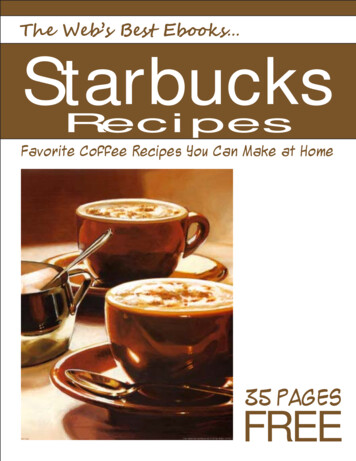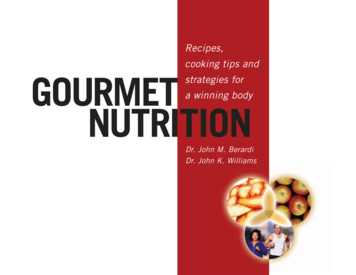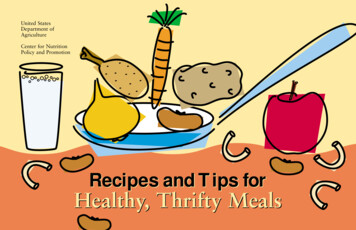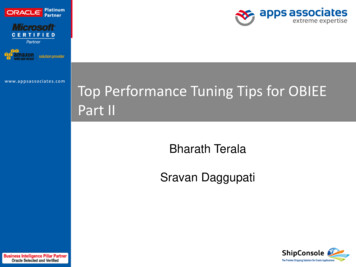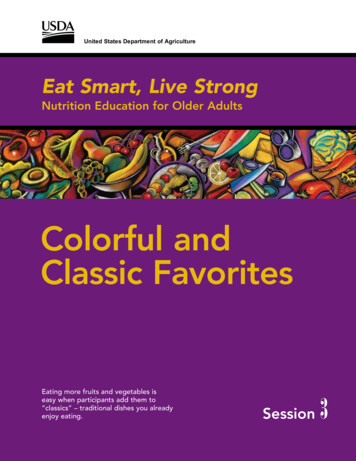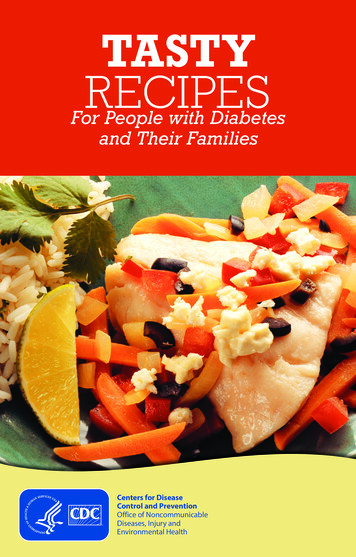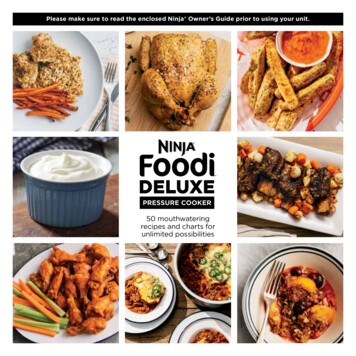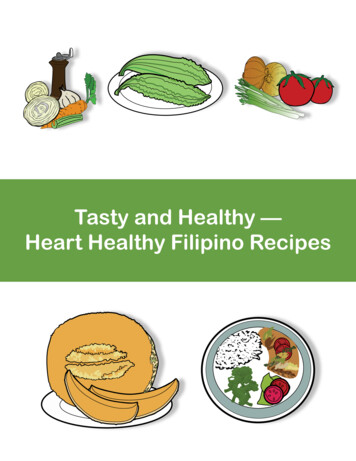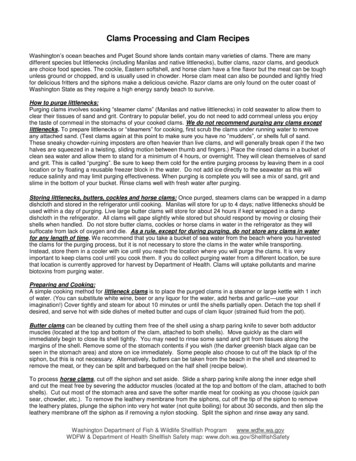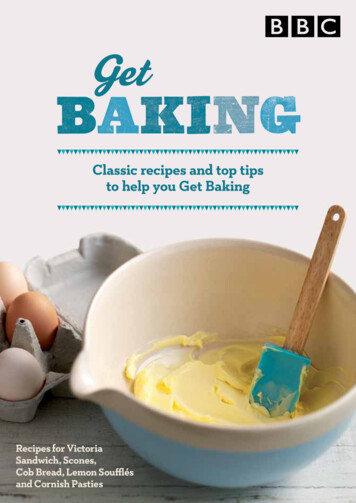
Transcription
Classic recipes and top tipsto help you Get BakingRecipes for VictoriaSandwich, Scones,Cob Bread, Lemon Soufflésand Cornish Pasties
Baking is a great British tradition – it is relaxing,rewarding and great fun. When we were makingthe BBC Two series The Great British Bake Off,we tasted cake, bread and biscuits from all overthe UK and were delighted to find that bakingis more popular than ever.Paul Hollywoodand Mary BerryNothing beats the taste of something that’s been bakedat home, and it’s really not difficult. With a good recipe andsome practice you’ll be amazed at what you can create.This guide will help you get started with five classic recipesand step-by-step advice. Learn how to make the perfectVictoria Sandwich, tasty Scones, a crusty Cob Loaf, hotLemon Soufflés, or delicious Cornish Pasties. The recipeshere were attempted by contestants on The Great BritishBake Off and they’re the perfect introduction to baking.Find out about the essential elements of great baking andlearn how to get brilliant results with some of our top bakingtips. And if you’re a complete beginner, go online and let usshow you how it’s done.Once you’ve built your confidence, we hope you’ll useyour new baking skills to raise money for BBC Children inNeed. Whether you hold a cake stall or a cake auction, youcan help make a difference for children across the UK.So if you’re crazy for cake, can’t resist a biscuit, have a softspot for bread, a passion for puddings or can’t get enoughpies, there are no excuses – Get Baking!Get Baking for BBC Children in Needbbc.co.uk/food
ContentsVictoria Sandwich Scones Cob Loaf Lemon Soufflés Cornish Pasties Ask the Experts Bake it Better 371115192224All the recipes in this guide have step-by-stepadvice to help you bake beautifully.Remember the three golden rules:1. Read the recipe through before you start.2. Weigh and measure your ingredients carefully.3. Don’t open the oven door while you’re baking.And for extra help, go online to watch Mary andPaul demonstrating the recipes and techniques:bbc.co.uk/foodBefore you start, it’s worth checking that youhave some basic baking equipment: Scales Big and small mixing bowls Wooden spoon Tablespoon Teaspoon Whisk Rolling pin Oven gloves or thicktea towel Spatula Sieve1
OvensAll ovens vary and the number on the dialisn’t always the true temperature – so cookingtimes can only be used as a guide. An oventhermometer is a good tool.Conventional and gas ovens are hottest at thetop, so it’s best to bake on the middle shelf toavoid burning things before they’re cookedthrough. If your cakes start to brown too quickly,you can reduce the oven temperature by 10 Cor, towards the end of the cooking time, youcan cover them loosely with aluminium foil.Fan ovens provide a fiercer heat thanconventional ovens, so reduce the temperatureby 20 C – check your oven instruction booklet.Don't be tempted to open the oven door untilat least two thirds through a cake’s cooking time– the structure of the batter won’t be 'set' beforethis stage and the sudden change in temperaturecan cause it to collapse. If you need to look afterthis point, open the door a crack and shut it asgently as possible to minimise any change intemperature or blasts of cold air.2Butter, Spreads andpacket MargarineFats like butter, spreads and packet margarineincorporate air bubbles in cake batters tomake them rise, give a crumbly or flakytexture to pastry, and increase the lightnessof a loaf. They also give taste, adding richnessand moistness to the finished recipe.Butter is made from animal fat (milk), whilemargarine, baking spread and vegetable spreadsare made from blends of animal and vegetableoils, or just vegetable oils.Vegetable spreads are lower in saturated fats.Always check on the pack that a vegetablespread is suitable for baking because manyof the lighter or cholesterol-lowering versionswon't work as well.Baking spread gives excellent results in cakes –choose a spread with a minimum 58% fat. If youprefer to use butter or packet margarine, it’simportant that it’s at the right consistency –it should be soft and squishy but not oily.
Mary Berry’s Perfect Victoria SandwichThe traditional Victoria Sandwich is a baking classic and atasty teatime treat. This ‘all-in-one’ method is quick and easy.
Very EasyPreparationPreparation time:about 30 minutesCooking time:about 25 minutesMakes: 12 slicesIngredients 4 large free-range eggs 225g/8oz caster sugar, plus alittle extra for the finished cake 225g/8oz self-raising flour 2 level tsp baking powder 225g/8oz baking spread or softbutter at room temperature, plusa little extra to grease the tins Good-quality strawberryor raspberry jam Whipped cream (optional)EQuipment Scales 2 x 20cm or 8in round tins Baking parchment orgreaseproof paper Large mixing bowl Electric hand mixer orwooden spoon Damp cloth Spatula Palette knife or flat knife Clean tea towel Cooling rack4MethodStage one1. Weigh out the ingredients.2. Preheat the oven to 180 C (160 C fan assisted)/350F/Gas 4.3. Grease and line the sandwich tins – use a piece of bakingparchment or greaseproof paper to rub a little bakingspread or butter around the inside of the tins until thesides and base are lightly coated. Line the bottom ofthe tins with a circle of baking parchment or greaseproofpaper (draw around the base of the tin onto theparchment and cut out a circle to fit).4. Break the eggs into a large mixing bowl, then add thesugar, flour, baking powder and baking spread. Make surethe teaspoons of baking powder are level, not heaped,as too much baking powder can make the cake sink.5. Mix everything together until well combined. The easiestway to do this is with an electric hand mixer, but you canuse a wooden spoon. Put a damp cloth under your bowlwhen you’re mixing to stop it moving around. Be carefulnot to over-mix.6. Divide the mixture evenly between the tins – this doesn’tneed to be exact, but you can weigh the filled tins if youwant to check. Use the spatula to remove all of the mixturefrom the bowl and gently smooth the surface of the cakes.7. Place the tins on the middle shelf of the oven and bakefor about 25 minutes. Don’t be tempted to open the doorwhile they’re cooking, but after 20 minutes look throughthe door to check them.
TOP TIPThe finished cake mixture should be a soft ‘dropping’consistency and should fall off a spoon easily. Be carefulnot to over-mix – as soon as everything is blended youshould stop.Stage two8. The cakes are done when they’re pale golden-brown andcoming away from the edge of the tins. Press them lightlywith a finger to check – they should spring back. Removethem from the oven and set aside to cool in their tins for5 to 10 minutes. Then run a palette or flat knife aroundthe edge of the tin and carefully tip the cakes out ontoa cooling rack. To take your cakes out of the tins withoutleaving a wire rack mark, put a clean tea towel over thetin, put your hand onto the tea towel and tip the tin upsidedown. The cake should come out onto your hand and thetea towel – then you can turn it from your hand onto thewire rack.9. Set aside to cool completely.Stage three10. To assemble the cake, place one cake upside down onto aplate and spread it with plenty of jam. If you want to, youcan add whipped cream too.11. Top with the second cake, top side up. Sprinkle over thecaster sugar.5
Raising AgentsMilkBaking powder and bicarbonate of soda arechemical raising agents (as opposed to yeast,which is a fungus). They give sponges, scones,muffins and some biscuits their light texture.Milk and cream are added to slacken theconsistency, give a lighter result and addprotein and fat. Milk is also used in bread toadd a richness and a slight sweetness, but itshould be scalded (almost boiled) and cooledbeforehand to prevent the bread having aheavy crumb.Active raising agents give off bubbles ofcarbon dioxide, which help batter or doughrise. Once they reach a certain temperature inthe oven they stop working and the batter ordough sets. It's important not to open the ovendoor too early during cake baking – the batterneeds to set around the air bubbles first or thecake will collapse.Bicarbonate of soda is alkaline and needs anacid to get it working. Yoghurt, buttermilk andcream of tartar are commonly used to do this.Baking powder is a ready mix of bicarbonate ofsoda and an acid. It’s inactive as long as it’s dryand starts working when it comes into contactwith liquids.Once opened, raising agents have a limitedshelf life. To test if they're still active, add ateaspoon of raising agent to a small bowlof water – if it doesn’t bubble and fizz, throwit away.6Full-fat cow's milk is normally used in recipes,but semi-skimmed will work, although the resultwill be less creamy. Avoid using skimmed milk asit’s too watery for baking. Part or all of the milkcan be replaced with cream for a richer result –this works particularly well in scones.Goat's milk, sheep's milk and non-dairyalternatives such as soya or rice milk can besubstituted in most recipes, but check the labelas some brands may be unsuitable for baking.Whipped cream is used as a filling or topping.Always use double or whipping cream as thesehave a higher fat content. Single cream won'twhip. When whipping cream, stop as soon as softpeaks form – if you whip for too long, the creamwill turn to butter.
Paul Hollywood’s SconesThis simple recipe will give you soft and fluffy scones –perfect with jam and plenty of clotted cream.
EasyPreparationPreparation time:about 30 minutesCooking time: 10–15 minutesMakes: about 8 large sconesIngredients 500g/1lb 1oz strong bread flour,plus a little extra for rolling out 80g/3oz softened butter, plusa little extra to grease thebaking tray 80g/3oz caster sugar 2 eggs 25g/5 level tsp baking powder 250ml/81/2fl oz milk 1 free-range egg, beaten with alittle salt (for glazing) Butter Good-quality strawberry orraspberry jam Clotted creamEQuipment Scales Flat baking tray Wooden spoon Baking parchment orsilicone paper (not greaseproof) Round pastry cutter(about 7.5cm/3in wide) Rolling pin Pastry brush Cooling rack8Method1. Weigh out the ingredients.2. Preheat the oven to 220 C (200 C fan assisted)/425F/Gas 7.3. Lightly butter and line a baking tray with bakingparchment or silicone paper.4. Put 450g/151/2oz of the flour into a large bowl and add thebutter. Rub the flour and butter together with your fingersto create a crumble/breadcrumb-like mixture.5. Add the sugar, eggs and baking powder and use awooden spoon to turn the mixture gently. Make sure youmix all the way down to the bottom and incorporate all ofthe ingredients.6. Now add half of the milk and keep turning the mixturegently with the spoon to combine. Then add theremaining milk a little at a time and bring everythingtogether into a very soft, wet dough. You may not needto add all of the milk.7. Put most of the remaining flour onto a clean work surface.Tip the soft dough onto the flour and sprinkle the rest ofthe flour on top. The mixture will be wet and sticky.8. Lightly chaff the mixture – use your hands to fold thedough in half, and then turn the dough a quarter turn andrepeat. By folding and turning the mixture in this way, youincorporate the last of the flour and add air. Do this a fewtimes until you’ve formed a smooth dough. If the mixtureis too sticky use some extra flour to coat your hands or themixture to make it more manageable. Be careful not tooverwork your dough.
TOP TIPDip the edge of the pastry cutter in flour to make iteasier to cut out the scones without them sticking. Don’ttwist the cutter – this makes the scones rise unevenly –just press firmly, then lift up and push the dough out.9. Next roll the dough out – sprinkle flour onto the worksurface and the top of the dough. Use the rolling pin toroll up from the middle and then down from the middle.Turn the dough a quarter turn and repeat until it’s about2.5cm/1in thick. Relax the dough slightly by lifting theedges and allowing the dough to spring back.10. Using a pastry cutter, stamp out rounds and place themonto the baking tray. Once you’ve cut 4 or 5 rounds youcan re-work and re-roll the dough to make it easier to cutout the remaining rounds. Any left-over dough can beworked and rolled again, but the resulting scones won’tbe as fluffy.11. Place the scones on the baking tray and leave them to restfor a few minutes to let the baking powder work. Then usea pastry brush (or your finger if you don’t have a brush)to glaze them with the beaten egg and salt mixture. Becareful to keep the glaze on the top of the scones. If itruns down the sides it will stop them rising evenly.12. Bake in the middle of the oven for 15 minutes, or until thescones are risen and golden.13. Leave the scones to cool, then split in half andadd butter, jam and clotted cream to serve.9
FlourYeastIt's important to choose the right flour for yourrecipe. Bread needs a strong flour with a highgluten content. Gluten is the protein that isstretched during kneading to give a soft, elasticdough and a well-risen loaf with a soft texture.Yeast is a single-cell fungus that is used tomake bread rise. When yeast is given air andfood (sugar and flour) in a warm environment(a standard kitchen as opposed to the fridge),the yeast will grow quickly and produce lotsof carbon dioxide. It's this carbon dioxide thatcauses bread to rise. Yeast dies at 60 C, soonce it’s done its job and the bread has risen,it’s killed off in the oven.A softer flour, lower in gluten and finely milled,is used to make cakes and pastry light and fluffy.Using a flour with a high gluten content makescakes tough or rubbery. Softer flours are usuallysold as plain flour or self-raising flour. Cakerecipes that use plain flour will usually ask for theaddition of baking powder or bicarbonate ofsoda. Self-raising flour is plain flour ready-mixedwith raising agents.Wholemeal flour can be substituted for whiteflour,
1 All the recipes in this guide have step-by-step advice to help you bake beautifully. Remember the three golden rules: 1. Read the recipe through before you start.
